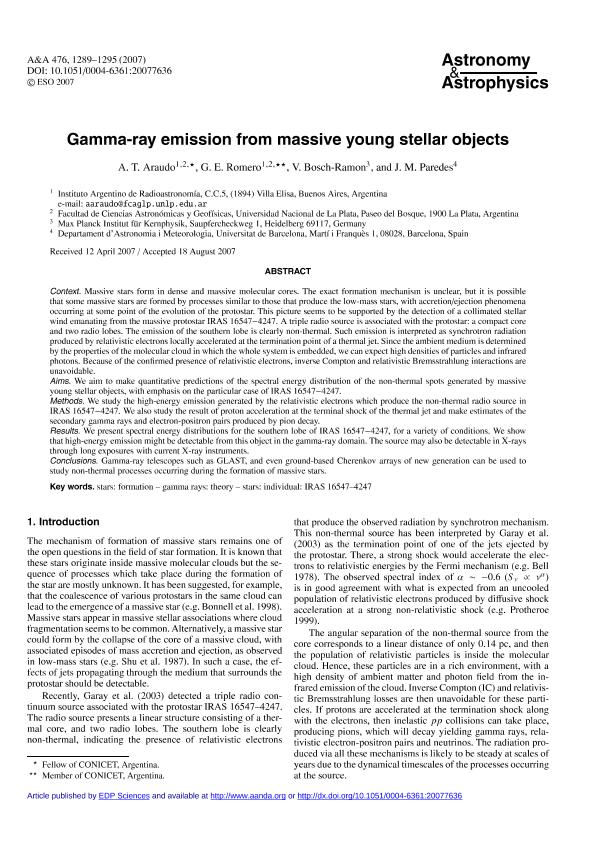Mostrar el registro sencillo del ítem
dc.contributor.author
Araudo, Anabella Teresa

dc.contributor.author
Romero, Gustavo Esteban

dc.contributor.author
Bosch Ramon, Valentí

dc.contributor.author
Paredes, Josep Maria

dc.date.available
2017-11-30T17:12:55Z
dc.date.issued
2007-12
dc.identifier.citation
Araudo, Anabella Teresa; Romero, Gustavo Esteban; Bosch Ramon, Valentí; Paredes, Josep Maria; Gamma-ray emission from massive young stellar objects; EDP Sciences; Astronomy and Astrophysics; 476; 12-2007; 1289-1295
dc.identifier.issn
0004-6361
dc.identifier.uri
http://hdl.handle.net/11336/29337
dc.description.abstract
Context. Massive stars form in dense and massive molecular cores. The exact formation mechanism is unclear, but it is possible that some massive stars are formed by processes similar to those that produce the low-mass stars, with accretion/ejection phenomena occurring at some point of the evolution of the protostar. This picture seems to be supported by the detection of a collimated stellar wind emanating from the massive protostar IRAS 16547−4247. A triple radio source is associated with the protostar: a compact core and two radio lobes. The emission of the southern lobe is clearly non-thermal. Such emission is interpreted as synchrotron radiation produced by relativistic electrons locally accelerated at the termination point of a thermal jet. Since the ambient medium is determined by the properties of the molecular cloud in which the whole system is embedded, we can expect high densities of particles and infrared photons. Because of the confirmed presence of relativistic electrons, inverse Compton and relativistic Bremsstrahlung interactions are unavoidable. Aims. We aim to make quantitative predictions of the spectral energy distribution of the non-thermal spots generated by massive young stellar objects, with emphasis on the particular case of IRAS 16547−4247. Methods. We study the high-energy emission generated by the relativistic electrons which produce the non-thermal radio source in IRAS 16547−4247. We also study the result of proton acceleration at the terminal shock of the thermal jet and make estimates of the secondary gamma rays and electron-positron pairs produced by pion decay. Results. We present spectral energy distributions for the southern lobe of IRAS 16547−4247, for a variety of conditions. We show that high-energy emission might be detectable from this object in the gamma-ray domain. The source may also be detectable in X-rays through long exposures with current X-ray instruments. Conclusions. Gamma-ray telescopes such as GLAST, and even ground-based Cherenkov arrays of new generation can be used to study non-thermal processes occurring during the formation of massive stars.
dc.format
application/pdf
dc.language.iso
eng
dc.publisher
EDP Sciences

dc.rights
info:eu-repo/semantics/openAccess
dc.rights.uri
https://creativecommons.org/licenses/by-nc-sa/2.5/ar/
dc.subject
Formation of Stars
dc.subject
Gamma Rays
dc.subject
Iras 16547-4247 (Estrella)
dc.subject
Massive Stars
dc.subject.classification
Astronomía

dc.subject.classification
Ciencias Físicas

dc.subject.classification
CIENCIAS NATURALES Y EXACTAS

dc.title
Gamma-ray emission from massive young stellar objects
dc.type
info:eu-repo/semantics/article
dc.type
info:ar-repo/semantics/artículo
dc.type
info:eu-repo/semantics/publishedVersion
dc.date.updated
2017-10-12T19:38:18Z
dc.journal.volume
476
dc.journal.pagination
1289-1295
dc.journal.pais
Francia

dc.journal.ciudad
Les Ulis Cedex A
dc.description.fil
Fil: Araudo, Anabella Teresa. Provincia de Buenos Aires. Gobernación. Comisión de Investigaciones Científicas. Instituto Argentino de Radioastronomía. Consejo Nacional de Investigaciones Científicas y Técnicas. Centro Científico Tecnológico Conicet - La Plata. Instituto Argentino de Radioastronomía; Argentina
dc.description.fil
Fil: Romero, Gustavo Esteban. Provincia de Buenos Aires. Gobernación. Comisión de Investigaciones Científicas. Instituto Argentino de Radioastronomía. Consejo Nacional de Investigaciones Científicas y Técnicas. Centro Científico Tecnológico Conicet - La Plata. Instituto Argentino de Radioastronomía; Argentina
dc.description.fil
Fil: Bosch Ramon, Valentí. Max Planck Institut für Kernphysik; Alemania
dc.description.fil
Fil: Paredes, Josep Maria. Universidad de Barcelona; España
dc.journal.title
Astronomy and Astrophysics

dc.relation.alternativeid
info:eu-repo/semantics/altIdentifier/doi/http://dx.doi.org/10.1051/0004-6361:20077636
dc.relation.alternativeid
info:eu-repo/semantics/altIdentifier/url/https://www.aanda.org/articles/aa/abs/2007/48/aa7636-07/aa7636-07.html
Archivos asociados
